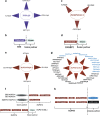Nucleoporin genes in human diseases
- PMID: 27071718
- PMCID: PMC5027676
- DOI: 10.1038/ejhg.2016.25
Nucleoporin genes in human diseases
Abstract
Nuclear pore complexes (NPCs) are large channels spanning the nuclear envelope that mediate nucleocytoplasmic transport. They are composed of multiple copies of ~30 proteins termed nucleoporins (NUPs). Alterations in NUP genes are linked to several human neoplastic and non-neoplastic diseases. This review focuses on NUPs, their genes, localization, function in the NPC and involvement in human diseases.
Figures


Similar articles
-
Moonlighting nuclear pore proteins: tissue-specific nucleoporin function in health and disease.Histochem Cell Biol. 2018 Dec;150(6):593-605. doi: 10.1007/s00418-018-1748-8. Epub 2018 Oct 25. Histochem Cell Biol. 2018. PMID: 30361777 Review.
-
Nuclear pore proteins and the control of genome functions.Genes Dev. 2015 Feb 15;29(4):337-49. doi: 10.1101/gad.256495.114. Genes Dev. 2015. PMID: 25691464 Free PMC article. Review.
-
Advances in the understanding of nuclear pore complexes in human diseases.J Cancer Res Clin Oncol. 2024 Jul 30;150(7):374. doi: 10.1007/s00432-024-05881-5. J Cancer Res Clin Oncol. 2024. PMID: 39080077 Free PMC article. Review.
-
Quantifying nucleoporin stoichiometry inside single nuclear pore complexes in vivo.Sci Rep. 2015 Mar 23;5:9372. doi: 10.1038/srep09372. Sci Rep. 2015. PMID: 25797490 Free PMC article.
-
You are who your friends are-nuclear pore proteins as components of chromatin-binding complexes.FEBS Lett. 2023 Nov;597(22):2769-2781. doi: 10.1002/1873-3468.14728. Epub 2023 Sep 7. FEBS Lett. 2023. PMID: 37652464 Free PMC article. Review.
Cited by
-
Downregulation of NUP93 aggravates hypoxia-induced death of cardiomyocytes in vitro through abnormal regulation of gene transcription.Acta Pharmacol Sin. 2023 May;44(5):969-983. doi: 10.1038/s41401-022-01036-9. Epub 2023 Feb 20. Acta Pharmacol Sin. 2023. PMID: 36807413 Free PMC article.
-
Obesity-associated gene TMEM18 has a role in the central control of appetite and body weight regulation.Proc Natl Acad Sci U S A. 2017 Aug 29;114(35):9421-9426. doi: 10.1073/pnas.1707310114. Epub 2017 Aug 15. Proc Natl Acad Sci U S A. 2017. PMID: 28811369 Free PMC article.
-
Moderate Nucleoporin 133 deficiency leads to glomerular damage in zebrafish.Sci Rep. 2019 Mar 18;9(1):4750. doi: 10.1038/s41598-019-41202-4. Sci Rep. 2019. PMID: 30894603 Free PMC article.
-
Expanding the phenotype of NUP85 mutations beyond nephrotic syndrome to primary autosomal recessive microcephaly and Seckel syndrome spectrum disorders.Hum Mol Genet. 2021 Nov 1;30(22):2068-2081. doi: 10.1093/hmg/ddab160. Hum Mol Genet. 2021. PMID: 34170319 Free PMC article.
-
Characterising proteolysis during SARS-CoV-2 infection identifies viral cleavage sites and cellular targets with therapeutic potential.Nat Commun. 2021 Sep 21;12(1):5553. doi: 10.1038/s41467-021-25796-w. Nat Commun. 2021. PMID: 34548480 Free PMC article.
References
-
- Wälde S, Kehlenbach RH: The Part and the Whole: functions of nucleoporins in nucleocytoplasmic transport. Trends Cell Biol 2010; 20: 461–469. - PubMed
-
- Jamali T, Jamali Y, Mehrbod M, Mofrad MR: Nuclear pore complex: biochemistry and biophysics of nucleocytoplasmic transport in health and disease. Int Rev Cell Mol Biol 2011; 287: 233–286. - PubMed
-
- Hoelz A, Debler EW, Blobel G: The structure of the nuclear pore complex. Annu Rev Biochem 2011; 80: 613–643. - PubMed
-
- Busayavalasa K, Chen X, Farrants AK, Wagner N, Sabri N: The Nup155-mediated organisation of inner nuclear membrane proteins is independent of Nup155 anchoring to the metazoan nuclear pore complex. J Cell Sci 2012; 125: 4214–4218. - PubMed
Publication types
MeSH terms
Substances
LinkOut - more resources
Full Text Sources
Other Literature Sources
Medical

